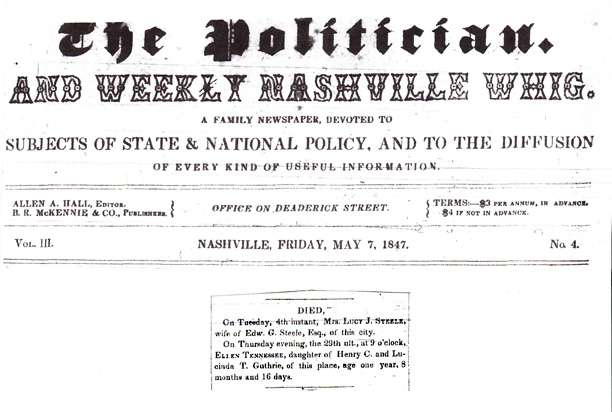Steele, Lucy Rawlins Lucy Rawlins Steele Rock placed over her Marker placed 2015 Davidson County Marriage Book 1 Documentation 1908 Plat: Sketch of “Rock” Section 18 Lot 9 Survey Visit: 3-30-2014 |
|
|
History of Lucy Rawlins and Edward G. Steel
Rev. William Hume, Presbyterian preacher, had performed the marriage of Ann Rawlins to Charles H. Sanders on August 29, 1832, and less than three months later, on November 16, 1832, the marriage of Lucy Rawlins to Edward G. Steel. On June 18, 1844, Edward G. Steel was appointed Secretary to the Board of Commissioners in charge of construction of the State House (State Capitol). Two months before, the Board had selected a rock quarry and had arranged with the Penitentiary for prisoners to prepare the stone of the State House. Mr. Steel served as the Secretary until he moved to New Orleans in late 1849. With Mr. Steel’s departure went the knowledge of the person buried beneath the so-called “Rock” or “Ivy Stone.” Local newspapers began to write romantic stories about this unusual marker at City Cemetery. The earliest newspaper story, located to date, is January 25, 1870. All the stories were tragic and usually involved a bride-to-be or a young married lady. From a lover’s quarrel resulting in the suicide of the future bride or to an accidental death of a recent bride on her wedding day were the general themes. The City Sexton set the record straight, in the Daily American, August 14, 1882, when he said “there isn’t any truth in all those romances that young people are so fond of telling and believing about the ivy stone.” The Sexton said that Mr. Steel had the rock taken from the quarry to the cemetery to cover his wife’s grave. A high wagon was drawn by eight mules to move the stone from the quarry to the cemetery. And six convicts were taken along to aid in unloading it. Further, the Sexton concluded, “He put it there and then spoiled nature with art by putting that iron fixture on the top, as I said to him at the time.” Daily American, August 14, 1882, and Nashville Banner, May 28, 1898, both reported that the ivy had been cut away from the rock and a faint inscription could be read: Lucy Rawlins Steele ***** Death Notice The Politician and Weekly Nashville Whig, Friday, May 7, 1847. The fanciful stories still continued in print. As late as 1943, City Cemetery historian repeated the story of the lover’s quarrel. In 1971, Jill Garrett, who was involved with recording inscriptions are City Cemetery, made an interesting comment: “For many years there were no dates nor name on this stone but during the restoration work these were added.” Jill Garrett was referring to the 1959 restoration work at the City Cemetery at which time a plaque with “Ann Rawlins Sanders 1815-1836” was placed on The Rock. Fletch Coke. 7-15-2014 Inset image from the 1908 Plat, Section 18
|
|
|
|
|



 Edward G. Steel buried his wife Lucy at City Cemetery on May 6, 1847, near the grave of Ann Rawlins Sanders who had died in 1836. A month after Lucy’s death, on June 8, 1847, Mr. Steel purchased Lot 9 in Section 18 where the graves of Ann and Lucy were located.
Edward G. Steel buried his wife Lucy at City Cemetery on May 6, 1847, near the grave of Ann Rawlins Sanders who had died in 1836. A month after Lucy’s death, on June 8, 1847, Mr. Steel purchased Lot 9 in Section 18 where the graves of Ann and Lucy were located.
